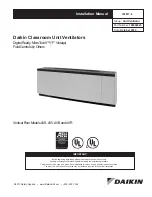
41
CV
Trouble-shooting
Full heating power but no regulation
Full heating power but no regulation
No heating
No heating
CV ..-..-1PTEM / CV ..-..-1PTEML
CV ..-..-1PTU / CV ..-..-1PTUL
CV ..-..-1P / CV ..-..-1PL
CV ..-..-1PQEM / CV ..-..-1PQEML
CV ..-..-1PQU / CV ..-..-1PQUL
●
●
Deactivate the limitation function (CV ..-..-1PTEM / -1PTEML), if it is activated, by making sure that the jumpers ”MIN” and ”MAX” are open.
Strap/short-circuit the terminals for the main sensor.
If this results in the heating now being turned off, then the fault is in the external sensor circuitry.
The fault is not in the duct heater, check the external regulator/thermostat.
●
●
●
Check that the sensor is of the correct type and that its termination is made correctly.
Check that the correct function for the Pulser is selected.
Check the resistance of the sensor and the set value potentiometer. Disconnect them from the terminals before any measurements is taken.
Sensors for 0...30°C should have the resistance 10k
@ 30°C, 11. k
@ 20°C and 15k
@ 0°C.
The external set value potentiometer should have the resistance 0...5k .
7
Ω
Ω
Ω
Ω
●
●
The same procedure as above for the CV ..-..-1PTEM / -1PTEML / -1PTU / -1PTUL type of heaters, but furthermore:
Check that the airflow through the heater is sufficient. The airflow is insufficient if the yellow LED on the PCB is light up, alternatively the
airflow might be sufficient but too turbulent for the electronics to sense the airflow correctly and then the yellow LED will remain light up
and the loss of heat will also remain. However, the airflow sensing device require a couple of minutes to heat itself after the power supply
has been switched on. During that period of time the yellow LED will remain light up, even though the airflow through the heater is sufficient.
●
●
●
●
Check whether or not the overheating cut-out, with manual reset, has been activated. If it has, then eliminate the fault and reset it.
Read furthermore the paragraph ”Overheating” at page 9.
Check the overheating cut-outs and the heating elements by measurments.
Check whether or not there is mains voltage at the heater terminal block. Check interlockings, fuses, switches, etc.
Disconnect the sensor from the terminals.
●
●
●
Check whether or not the overheating cut-out, with manual reset, has been activated. If it has, then eliminate the fault and reset it.
Read furthermore the paragraph ”Overheating” at page 9.
Check the overheating cut-outs and the heating elements by measurments.
Check whether or not there is mains voltage at the heater terminal block. Check interlockings, fuses, switches, etc.
If the heater starts now, then the fault is in the external sensor circuitry. Otherwise, the fault is in the regulator (Pulser).
Full heating power but no regulation
No heating
CV ..-..-1PTX / CV ..-..-1PTXL
CV ..-..-1PTY / CV ..-..-1PTYL
CV ..-..-1PTP / CV ..-..-1PTPL
CV ..-..-1PQX / CV ..-..-1PQXL
CV ..-..-1PQY / CV ..-..-1PQYL
CV ..-..-1PQP / CV ..-..-1PQPL
Disconnect the control signal wiring and strap/short-circuit the control signal input terminals.
●
If this results in the heating now being turned off, then the fault is in the external control signal.
●
Make sure that the control signal has the correct polarity.
●
●
The same procedure as above for the CV ..-..-1PTX / -1PTXL / -1PTY / -1PTYL / -1PTP / -1PTPL type of heaters, but furthermore:
Check that the airflow through the heater is sufficient. The airflow is insufficient if the yellow LED on the PCB is light up, alternatively the
airflow might be sufficient but too turbulent for the electronics to sense the airflow correctly and then the yellow LED will remain light up
and the loss of heat will also remain. However, the airflow sensing device require a couple of minutes to heat itself after the power supply
has been switched on. During that period of time the yellow LED will remain light up, even though the airflow through the heater is sufficient.
●
●
●
●
Check whether or not the overheating cut-out, with manual reset, has been activated. If it has, then eliminate the fault and reset it.
Read furthermore the paragraph ”Overheating” at page 9.
Check the overheating cut-outs and the heating elements by measurment.
Check whether or not there is mains voltage and control signal at the heater terminal blocks. Check the interlocking devices, fuses, breakers, etc.
Disconnect the control signal wiring and connect a 9V battery-cell or another suitable voltage source as a control signal.
If the heater doesn’t start now, then the fault is in the regulator (Pulser).
Содержание CV Series
Страница 21: ...CV E MTEM R 21...
Страница 23: ...CV E MTEM R 23...
Страница 35: ...CV E MTEM R 35...
Страница 39: ...CV E MTEM R 39 RU CV E R...
Страница 62: ...CV M MTU MTX MTP 22...
Страница 67: ...CV M MTU MTX MTP 27 CV 1MTUL 230V...
Страница 88: ...CV M MTU MTX MTP 48 RU CV M...
Страница 89: ...CV M MTU MTX MTP 49...
Страница 90: ...CV M MTU MTX MTP 50...
Страница 91: ...CV M MTU MTX MTP 51...
Страница 116: ...24 CV...
Страница 126: ...34 CV...
Страница 139: ...47 CV...
Страница 151: ...59 CV...
Страница 183: ...31 CV...
Страница 187: ...35 CV...
Страница 191: ...39 CV...
Страница 198: ...46 CV...
Страница 199: ...47 CV...








































